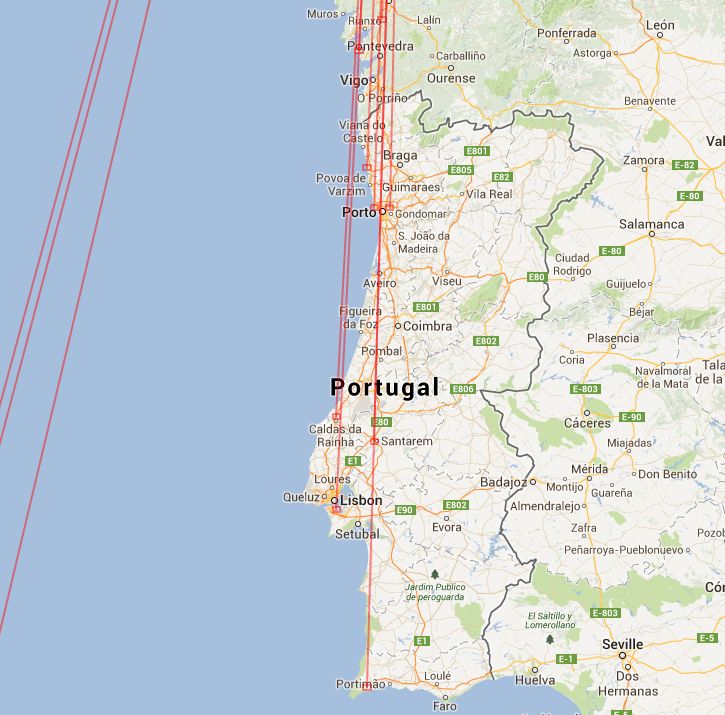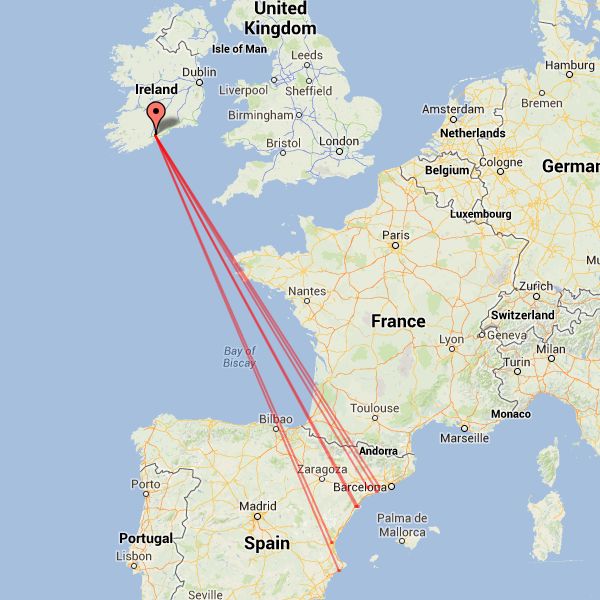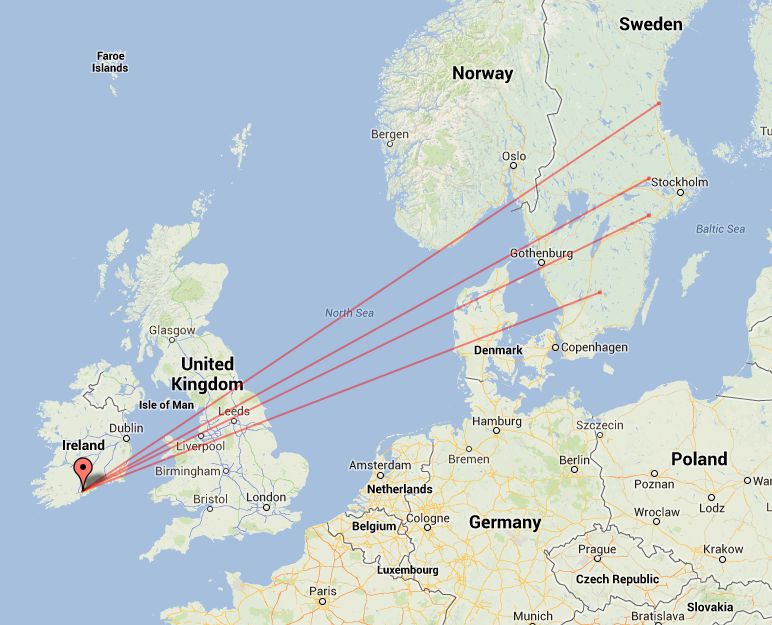There had been much anticipation of a decent tropo opening around the 23rd September with a large, stable area of high pressure forming over north west Europe. In the end it turned into something that people will remember for a long time, with some fabulous contacts made. I can’t wait to see reports from the likes of GI4SNA, OM2VL, S51ZO, and others, which I’m sure will be amazing!
Here’s my own story, with apologies for the length…
The Hepburn forecast map was looking good with a nice yellow/orange area predicting long-distance potential:

Hepburn’s tropo prediction for 06z on 23/09/13
On the morning of 22nd September things started to look promising, with a few reasonable contacts over 800km to the east and south – not huge signals, but it was something:
22/09/2013 06:30 DG0VOG JO60QU 519 519 2 m. 1496km
22/09/2013 06:35 PA3GGI JO21TV 539 529 2 m. 947km
22/09/2013 06:38 DL6YBF JO31OX 59 59 2 m. 1054km
22/09/2013 06:42 F4EGA JO10QK 54 51 2 m. 823km
22/09/2013 06:47 PA2CHR JO32DB 59 59 2 m. 991km
22/09/2013 06:53 PA4VHF JO32JE 57 55 2 m. 1024km
22/09/2013 07:05 ON4KHG JO10XO 58 56 2 m. 858km
22/09/2013 07:11 ON4KBE JO20BI 559 559 2 m. 877km
22/09/2013 07:49 DK3EE JO41GU 54 41 2 m. 1146km
22/09/2013 08:12 PE9GG JO33NA 59 59 2 m. 1043km
22/09/2013 08:19 PA5MS JO21RQ 55 54 2 m. 938km
22/09/2013 08:31 DF0MU JO32PC 529 519 2 m. 1058km
22/09/2013 08:34 PA1VW JO22IN 549 559 2 m. 881km
22/09/2013 08:42 ON4BR JO20SW 549 439 2 m. 958km
22/09/2013 08:47 PA2DW JO22GD 55 55 2 m. 871km
22/09/2013 09:02 PD0HCV JO31FW 57 57 2 m. 1003km
22/09/2013 09:17 DK1FG JN59OP 519 319 2 m. 1384km
22/09/2013 10:42 EA1DHB/P IN83FD 51 52 2 m. 1038km
22/09/2013 10:44 EA2TO/P IN83FD 51 51 2 m. 1038km
Later that evening and into the morning of the 23rd September a few more signals appeared:
22/09/2013 22:32 DG0VOG JO60QU 51 519 1496km
22/09/2013 22:46 DM7RM/P JN48JC 51 519 1283km
23/09/2013 06:50 DL8MAI JN57FV 519 529 1405km
23/09/2013 07:06 DF1CF JN57FP 519 529 1417km
23/09/2013 08:05 HB3YAT JN47JM RO RO 1313km
23/09/2013 09:18 DF1CF JN57FP 57 52 1417km
Once again the signals were not too strong, but the distances were very good: This usually indicates there’s a good high-level (mid-tropospheric) duct somewhere along the path, but it is almost certainly extended at one or both ends by a local low-level inversion. There was certainly one at my end of the path, if the thick fog here was anything to go by.
After the QSO with DF1CF @09:18z things started to go downhill very rapidly as the local inversion lifted, to the point where the band seemed absolutely dead more-or-less everywhere. This was disappointing, because it showed that few, if any, people were able to directly access the mid-tropospheric duct at this time – probably because it was at too high an altitude (indications are it was then >1400m above sea level). Over time there was no doubt the high-level duct would descend, as it always does, but of course the high pressure system itself would also move. There was plenty of nail-biting at ‘3KD, hoping the duct would come directly into range at some point!
Luckily, this is where well-sited beacons show how useful they are: HB9HB (JN37qf/1226km) is located at 1395m asl and was a constant signal even when everything else had faded, confirming the duct was still present. Indeed it grew in strength, thus raising hopes…
Then, at around 12z, the first “properly ducted” signal suddenly appeared, from OE2XRM (JN67nt/1589km)! It took a few calls to attract his attention through the instant pile-up, but a nice QSO resulted. I didn’t have the audio recorder running at the time, but made this recording just a few minutes later:
Soon after, more and more signals started to appear from a similar direction, characterised by good signal strengths disturbed by very deep and rapid fading. The distances were great, varying from 800 to over 1500km:
23/09/2013 12:15 OE2XRM JN67NT 55 559 1589km
23/09/2013 13:05 F0FYP JN37LO 55 55 1188km
23/09/2013 13:30 F6DCD JN38RQ 569 569 1167km
23/09/2013 13:35 DJ9EV JN49SC 55 52 1290km
23/09/2013 13:50 DK1FG JN59OP 58 58 1384km
23/09/2013 14:00 OK1ES JO60RN 529 419 1510km
23/09/2013 14:09 HB9SLU JN36MU 54 51 1236km
23/09/2013 14:42 DF9RJ JN68GS 55 53 1508km
23/09/2013 14:48 DK3XT JN49FE 559 559 1213km
23/09/2013 14:51 HB9BNI JN37WB 559 559 1278km
23/09/2013 15:13 DL2GPS JN48CD 54 41 1242km
23/09/2013 15:25 F5BLD JN38WS 549 559 1191km
23/09/2013 15:33 DL2OM JO30SN 599 559 1104km
23/09/2013 15:36 DL5MCG JN58KH 53 58 1414km
23/09/2013 15:39 DL8NP JN58SC 559 569 1468km
23/09/2013 15:44 DL0SA JN58SC 549 539 1468km
23/09/2013 15:48 OE5RBO JN68OB 559 559 1583km
23/09/2013 15:55 F5SE/P JN19XH 59 59 905km
23/09/2013 16:02 F5SE/P JN19XH 539 519 905km (70cm)
23/09/2013 16:07 F6IHC JO10OQ 58 55 804km
23/09/2013 16:09 F5JNX JN37PV 589 599 1194km
23/09/2013 16:11 F6ACU JN38FC 599 599 1128km
23/09/2013 16:17 DJ3OS JN49FL 51 57 1202km
23/09/2013 16:19 F1NPX/P JN29DH 57 59 927km
23/09/2013 16:22 F5MFO JN19IB 579 559 834km
23/09/2013 16:29 DF7RG JN68HG 569 569 1534km
23/09/2013 16:30 OK2BY JN69JJ 559 559 1501km
23/09/2013 16:34 DK1KW JN58RE 529 559 1459km
I even had a QSO with F5SE/P (JN19xh/905km) on 432MHz – but more about my 70cm exploits later…
At 16:35z, I glimpsed a comment from Pista, HA1FV (JN87jj/1858km) in the ON4KST chat that he could hear me – but I already knew because, to my amazement, I could hear him calling! The signal was quite weak but an easy QSO resulted, most certainly via tropo from the duration and “sound” of the transmission – unfortunately I didn’t have the audio being recorded at the time, so no clip.
Some minutes later I was still getting over the shock of working Pista, and struggling to receive a French station who’d faded into the noise, when I heard “S51ZO S51ZO?” being sent on CW. I had half a mind that it was a wind-up, but went on to work Joze, S51ZO (JN86dr/1856km) very easily – I was amazed when he confirmed the QSO later in the KST chat! This time I remembered to turn the audio recorder on right at the end of the contact, so got a brief clip that indicates how good a signal it was:
Conditions were getting better all the time and I was very pleased, shortly after S51ZO, to work Frank OE3FVU (JN78ve/1754km). Signals were slightly down during our contact, although it was easy enough, but I made this recording of Frank very soon after:
More nice contacts followed, including many to the south of Germany and Austria:
23/09/2013 16:37 HA1FV JN87JJ 519 529 1858km
23/09/2013 16:43 F5LEN JN38BO 54 54 1081km
23/09/2013 16:45 F2GL JN17ST 549 569 957km
23/09/2013 16:50 S51ZO JN86DR 559 579 1856km
23/09/2013 16:53 DK2HZ JN48RW 539 539 1291km
23/09/2013 16:55 DL2DN JN48MX 599 599 1261km
23/09/2013 16:56 F6AFC JN38CM 599 599 1091km
23/09/2013 17:00 OE3FVU JN78VE 52 51 1754km
23/09/2013 17:01 DL8SCQ JN48RV 59 59 1293km
23/09/2013 17:02 F6GYH JN27TS 59 59 1092km
23/09/2013 17:04 DK2RY JN59KN 59 57 1364km
23/09/2013 17:05 F5FIM JN38IA 59 59 1149km
23/09/2013 17:06 F4ABV JN39FD 59 56 1079km
23/09/2013 17:07 DL6SDH JN48RW 56 56 1291km
23/09/2013 17:08 DL4NC JN59KO 54 52 1362km
23/09/2013 17:09 F2LU JN38UH 59 58 1201km
23/09/2013 17:46 DL8FL JN48XS 579 579 1332km
23/09/2013 17:48 DL6YBF JO31OX 559 559 1054km
23/09/2013 17:49 DL5FDP JN49LP 539 539 1230km
23/09/2013 17:52 F6DZS JN18EV 539 539 821km
23/09/2013 17:55 DL5MAE JN58VF 59 59 1480km 5 watts!
23/09/2013 17:57 DL5MAE JN58VF 579 559 1480km (70cm)
23/09/2013 18:12 DL6WU JN49HT 599 559 1201km
23/09/2013 18:14 DL5GAC JN47UT 599 599 1359km
23/09/2013 18:36 LX2LA JN39CP 59 59 1043km
23/09/2013 18:46 OE5XBL JN68PC 59 59 1587km
23/09/2013 18:48 OE5XBL JN68PC 51 539 1587km (70cm)
23/09/2013 19:04 OE3DSB JN78FA 52 55 1670km
23/09/2013 19:07 LX1DB JN39CO 59 59 1044km
23/09/2013 19:13 DJ0QZ JN49LM 59 59 1234km
Did you notice the two 70cms contacts in the log, with DL5MAE (JN58vf/1480km) and OE5XBL (JN68pc/1587km), and earlier with F5SE/P? The FT857d I use can run about 20 watts on 432MHz but I don’t have an antenna for 70cm. However, I know from past experience that 2m Tonna antennas, such as my 11el, are not too bad a match on 70cm – So these QSOs were made with the barefoot FT857d into the 11el 2m antenna! It’s a slightly complicated process to switch bands, because I have to disable the 2m masthead preamp and apply an offset to the antenna azimuth because the pattern is skewed on 70cm, but it worked 😀 Here’s the audio from the ‘MAE and ‘XBL QSOs with us QSYing from 2m up to 70cm:
At around 19:15z I was tuning around the band and came across a CW signal that sounded a bit “DX-ey”. I was astonished to hear, very clearly, “OM2VL OM2VL OM2VL”, but was so excited I a) immediately forget his call, and b) initially forgot to switch the rig from SSB to CW. It was a brilliant QSO with Laci, OM2VL (JN87wv/1909km), but the chaos is adequately heard in the following clip 😀 About ten minutes later I could hear Laci very clearly on SSB, and on telling him that in the KST chat he asked me to call again for a very nice SSB QSO:
This was the peak of the opening for me and conditions very slowly started to drop off, although a number of great contacts followed for the rest of the evening through to the following morning, including a fantastic CW QSO with Zvonko, 9A1CAL (JN86dm/1867km).
I heard a little later from Moma, YU1EV (KN04cn/2246km), that he had heard me 539 during my QSO with 9A1CAL – it’s such a shame I didn’t hear him call!
The rest of the log is here:
23/09/2013 19:17 OM2VL JN87WV 559 599 1909km
23/09/2013 19:20 OE5HSN JN68PC 55 55 1587km
23/09/2013 19:28 OM2VL JN87WV 55 59 1909km
23/09/2013 19:48 9A1CAL JN86DM 519 519 1867km
23/09/2013 19:49 DL8MFL JN58OA 599 599 1450km
23/09/2013 19:52 DH1VY JN39KF 599 599 1104km
23/09/2013 20:01 DF6MU JN58WF 599 599 1485km
23/09/2013 20:06 DD7PC JN49AX 569 529 1156km
23/09/2013 20:07 DJ5NE JN59LW 559 559 1357km
23/09/2013 20:09 DL4NAC JN59SV 599 599 1398km
23/09/2013 20:11 DL2GWZ JN49HQ 559 559 1206km
23/09/2013 20:15 DK3IK JN39JF 549 559 1098km
23/09/2013 20:17 DM5TI JN68FF 579 559 1525km
23/09/2013 20:20 F4JVG JN16NL 529 1021km
23/09/2013 20:22 OK7GU JN69QT 529 529 1526km
23/09/2013 20:24 OK1PGS JN69JW 529 559 1482km
23/09/2013 20:28 DL1NBM JN49MV 599 559 1227km
23/09/2013 20:56 DL1MAJ JN68AH 599 599 1493km
23/09/2013 22:00 DK3EE JO41GU 55 529 1146km
23/09/2013 22:47 HB9EOU JN37JC 52 51 1205km
23/09/2013 23:09 OE9MON JN47VM 57 57 1379km
24/09/2013 07:57 OK1TEH JO70FD RO RO 1590km
24/09/2013 08:52 DL6NAA JO50VF 55 55 1405km
24/09/2013 11:18 OE2JOM/2 JN67NT 58 51 1589km
24/09/2013 11:24 OE5XBL JN68PC 55 55 1587km
24/09/2013 11:44 ON4PS/P JO20KQ 559 559 918km
24/09/2013 11:46 DJ5BV JO30KI 559 569 1064km
24/09/2013 12:00 DK2EA JO50UF 419 539 1399km
24/09/2013 12:21 DL2AMD JO50VV 559 559 1387km
Finally, my > 800km QSO map for the period 22->24/09/13:

Tropo QSOs made from 22-24/09/13 by EI3KD > 800km
So that’s it, after 40-odd years of being a “2m addict”, the band is still capable of amazing and exciting things. Not many hobbies can do that, eh? 😀









